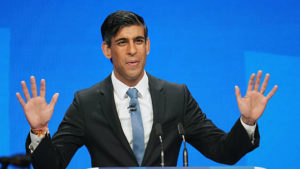Being a wealthy man from a wealthy family, the concept of being forced into debt may be hard for the Chancellor to grasp. But with a looming cost-of-living crisis linked to soaring energy bills threatening to overshadow May’s local elections, perhaps he could think about it in terms of his approval ratings. These are now in negative territory and heading the wrong way. He might also care to look at the ConHome Cabinet League Table, where he has just plunged to the bottom.
This is in large part due to his Spring Statement, which was a fiasco — a failure not just of empathy, but also of basic political judgement. However, he and Boris Johnson do have one last chance to turn this around — and that’s the forthcoming energy independence strategy. It’s due out on Thursday, but after weeks of wrangling between Downing Street and the Treasury, there’s no guarantee.
The Prime Minister — as always looking for the big, bold, willy-waving policy — wants to go nuclear. But he’s forgotten that the story of British nuclear is not a happy one.
It all began with such high hopes. In 1956, a young Queen Elizabeth II opened the world’s first nuclear power station, Calder Hall in Cumbria. As she said back then, “this new power, which has proved itself to be such a terrifying weapon of destruction is harnessed for the first time for the common good of our community”.
However, that wasn’t the whole truth. As well as generating electricity, the first generation of Magnox reactors were also designed to produce plutonium for nuclear weapons. The dual purpose meant they were never optimised for civilian use. Calder Hall was also next door to Windscale Pile No. 1 — which, in 1957, was the site of Britain’s worst nuclear accident.
In the Sixties, the next generation of Advanced Gas-cooled Reactors (AGR) was planned as a fresh start. But these too were a big disappointment. The first one opened 13 years late and the fleet as a whole has been plagued by technical problems. In the Eighties, Margaret Thatcher decided to give nuclear a third chance. The plan was to build ten new plants, based on the Pressurised Water Reactor (PWR) design. But due to escalating costs only one of these was ever built — Sizewell B.
In the 2000s, it was Tony Blair’s turn to bang his head against a brick wall. This time, the design of choice was the French-owned European Pressurised Reactor (EPR). Eight sites were planned; but to date, work has started on just one of them — Hinkley Point C. Predictably, it too has been hit by multiple delays and cost over-runs. It’s due open in 2026 — 70 years after Calder Hall — but the results of yet another cost review could mean that more bad news is on the way.
After seven decades and four failed attempts to make nuclear power work for Britain, Boris has decided that we should make a fifth attempt. He wants 25% of the Britain’s electricity to come from nuclear power. At the moment the figure is about 16% — most of which is from stations that are due to close by the end of this decade.
But over the past 40 years, we’ve only managed to build them at a rate of one per generation. What makes Boris think he can do ten times better? Moreover, this is a technology notorious for blowing through budgets. If it all goes wrong again, then with multiple projects we’ll pay a heavy price. Why then is there so little opposition to this high-risk strategy?
Possibly it’s because the public is so desperate for affordable energy. Supposedly unpopular forms of generation like onshore wind farms are anything but. These projects enjoy overwhelming support, even if they’re built close to where people live. According to the Sunday Times, Tory internal polling shows that support for renewables goes “off the charts” if local residents get discounted electricity. Nuclear is not as popular as wind or solar, but the same principle could apply: deal with the nimbies by stuffing their mouths with freebies.
Just how seriously is the Prime Minister taking his grand plan? Judging from a Johnsonian quip that “we should put a small nuclear reactor in every Labour seat” — the answer is not “not very”. It doesn’t help that the PM has a track record of promoting madcap schemes such as Boris Island or the bridge across the Irish Sea. Fortunately, those notions came to nothing, but on nuclear, who will stop his folie de grandeur?
Our best hope is Rishi Sunak. As a banker, he knows just how reluctant the private sector is to fund the construction of nuclear power stations. The risks are just too big. So it’s unlikely that we’ll get our new nukes unless the British Government shares in the cost of construction. Even a 10% share would mean finding billions in taxpayers’ money. Though the PM might be willing to risk our cash on a dodgy prospect, his penny-pinching Chancellor is reportedly horrified.
Remember, this is a technological challenge that has defeated the governments of Harold Wilson, Margaret Thatcher and Tony Blair — but, hilariously, we’re supposed to believe that Boris Johnson can succeed where his predecessors failed.
Even if these immensely complicated, decade-long construction projects were to go to plan, that would still leave the opportunity cost. Billions — perhaps, ten of billions — of pounds are at stake. Using this money to prop-up the French nuclear industry means not using it to level-up Britain as Boris promised he would. It means not investing in the energy industries where Britain should be leading the world, like offshore wind power and carbon capture. It means making this country a technology importer, when we desperately need to export our way back to prosperity. We will be a poorer, more indebted nation if we choose the nuclear option.
It also means a huge diversion of government effort away from the immediate energy needs of the British people. Winter is coming and so is the next 50% hike in our gas and electricity bills. We have just months to adequately insulate the homes of the most vulnerable households. It is this goal that should be consuming the Prime Minister’s political attention, not his nuclear fever dream.
Remember that the best case scenario for nuclear is that we’ll have a new generation of power stations coming online some time in the late 2030s. But the cost-of-living crisis demands urgency. Instead of gambling on a technology that has let us down again-and-again, Boris needs to concentrate on the here-and-now.
That means deploying the technologies that can make a difference by next year, not the next decade. Our national security is at stake, our household finances are at stake, and when temperatures begin to fall again, lives are at stake.
I realise that a roll of loft insulation doesn’t make for the most exciting of photo opportunities — especially for a gesture politician like Boris Johnson — but right now it might make all the difference.
Disclaimer
Some of the posts we share are controversial and we do not necessarily agree with them in the whole extend. Sometimes we agree with the content or part of it but we do not agree with the narration or language. Nevertheless we find them somehow interesting, valuable and/or informative or we share them, because we strongly believe in freedom of speech, free press and journalism. We strongly encourage you to have a critical approach to all the content, do your own research and analysis to build your own opinion.
We would be glad to have your feedback.
Source: UnHerd Read the original article here: https://unherd.com



